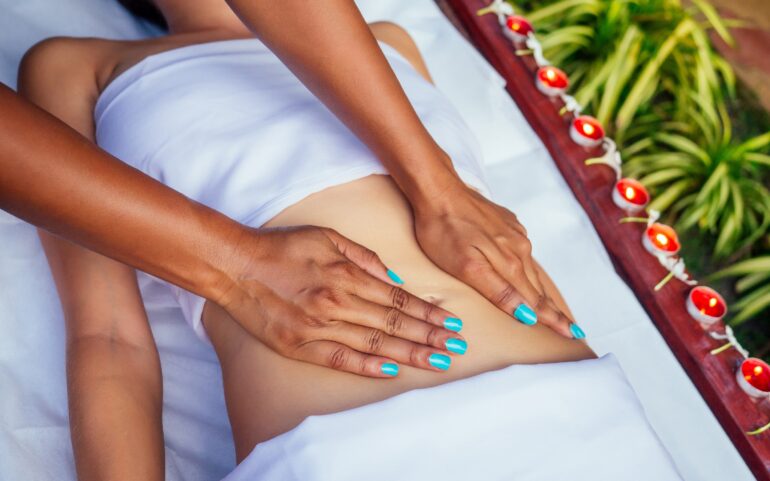Today’s post is going to try and explain this ancient treatment prescribed in the old Ayurvedic texts. Panchakarma has been successfully practiced for many centuries, in accordance with the great works of the ‘Charaka Samhita.´
Every human being is a unique phenomenon of cosmic consciousness manifested through the five basic elements, Ether, Air, Fire, Water and Earth. The 3 dosha types, Vata, Pitta, and Kapha, are each made up of two of these elements.
As described in the articles on Vata, Pitta and Kapha, each person has his or her own individual dosha type determined at the time of fertilization.
An imbalance can consist of an exaggerated or diminished dosha, the individual needing corrective therapy of this doshic imbalance.
Panchakarma is the corrective purification therapy used in Ayurvedic medicine. The Sanskrit word panchakarma means five(pancha) actions(karma) and refers to five different procedures intended to intensively perform detoxification and purification.
According to Ayurveda appropriate rejuvenation is a science and promotes longevity. Ayurveda aims to guide every individual in the proper choice of diet, habits and exercise.
Some of these measures can require a stay in a treatment facility, where Ayurvedic practitioners perform panchakarma. The length of Panchakarma normally ranges from 7-28 days in relaxing beautiful surroundings.
Panchakarma aims to restore balance in the body, mind and consciousness, hereby improving ones health status and hopefully cure disease.
Balance in terms of Ayurveda is when there’s complete equilibrium between the 3 doshas, the digestive fire(Agni) is in perfect condition, and the 3 waste products(malas) are produced and eliminated in an orderly manner.
This creates normal functioning of the seven tissues(dhatus). The mind, senses and the soul will be in harmony.
The individual balance between Vata, Pitta and Kapha can be disturbed by all kinds of factors, causing an imbalance. If the imbalance increases, disease might arise.
Panchakarma therapies
So, what are the 5 different actions in panchakarma?
Firstly the person undergoing the treatment must have his or her body prepared for the detoxification.
This entitles pre-purification measures in the form of oil massage(Shehan), performed by a professional Ayurvedic massage therapist, and after the massage there’s sweating(Svedana).
Oil massage helps to soften the tissues and move the toxins towards the gastrointestinal tract for elimination. Sweating out the toxins could be in a sauna or steam room in the Ayurvedic retreat.
By these processes the nervous system gets relaxed.
Hopefully the person moves into spending more time with an active para-sympathetic nervous system. In this state we’re able to receive nurture and use the nutrients given to us.
Now the Ayurvedic doctor will choose one or more cleansing methods fit for the persons constitution and imbalance. These procedures aim at plucking away the deep rooted imbalances in the body.

Vamana, therapeutic vomiting
This Ayurvedic treatment can be used in the case of excess Kapha, often present in the lungs and airways. The person might have persistent mucus problems causing asthma, bronchitis and the like. Getting rid of this mucus gives instant relief and sometimes an added positive effect, is a release of repressed emotions.
Vamana is rarely used in modern Panchakarma retreats, but replaced by other more mild therapies.
Virechan, laxative treatment
Purgation or laxative treatment accesses the gall bladder, liver and inflammation in general. In this case there’s an excess of Pitta in the body and this cathartic approach resolves the Pitta imbalance.
Basti, enema therapy
As Vata’s main seat in the body is in the colon, enemas with herbal oils, will resolve typical Vata disorders such as constipation, distension, backache, muscle spasms and headache. As Vata governs all movement in the body, it is the main force behind a healthy elimination.
Vata is the cause of a majority of diseases.
Nasya, treatment and elimination through the nose
In Ayurvedic terms the nose is the doorway to the brain and hence consciousness. Prana, the main life force according to Ayurveda, enters through the nose by breathing in. Nasya is indicated for sinus congestion, migraines, cognitive problems and more.
Rakta Moksha, detoxification of the blood
Extracting a small amount of blood from a vein relieves Pitta related toxins and can reduce Pitta disorders like rashes, hives, hypertension and an enlarged liver.
Like Vamana, Rakta Moksha is rarely used in modern Panchakarma retreats, but replaced by other more mild therapies.

After Panchakarma
Diet is important both during and after Panchakarma as the retreat can include intense cleanses and periods of fasting.
After the purification process the person should eat Kitchari whenever they feel hungry. Kitchari is an ancient Ayurvedic meal consisting of mung beans and rice. Kitchari is warm, delicious, satisfying and easy to digest.
This diet should be maintained for three to four days, slowly increasing the variety of other items like ginger, pepper, salt and soups, and increasing the quantity gradually.
You should also stay away from caffeine and other activating substances before, during and after panchakarma. (Maybe you never need them again?)
Having plenty of rest and abstaining from strenuous exercise around the Ayurvedic detox is important as the body’s systems need to reset and rejuvenate.
Panchakarma at home
Panchakarma is a program done specifically for the individual by a professional and experienced Ayurvedic practitioner. The 5 therapies should not be practiced at home from a book or an article, as it could do more harm than good.
However, at home you can do some small, but great changes to your daily routine. You can choose to ease digestion by cooking Kitchari and drinking tea suited for your constitution.
You can do Ayurvedic Self-Massage (Abhyanga) with oil only a daily basis. Additionally, you can make sure your rest, sleep and relationships are maintained and nurtured.
Albeit ancient science, in the stressful society we live in, it seems Ayurvedic rejuvenation and purification could be the natural way to restore balance.





